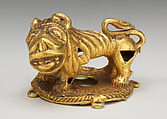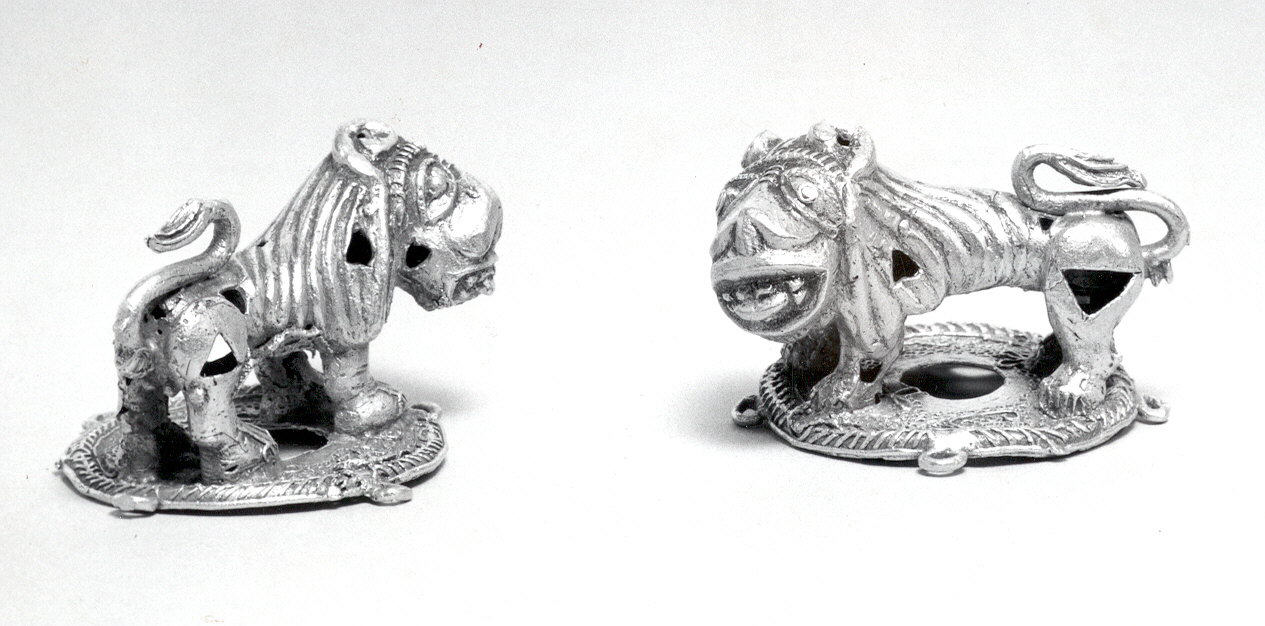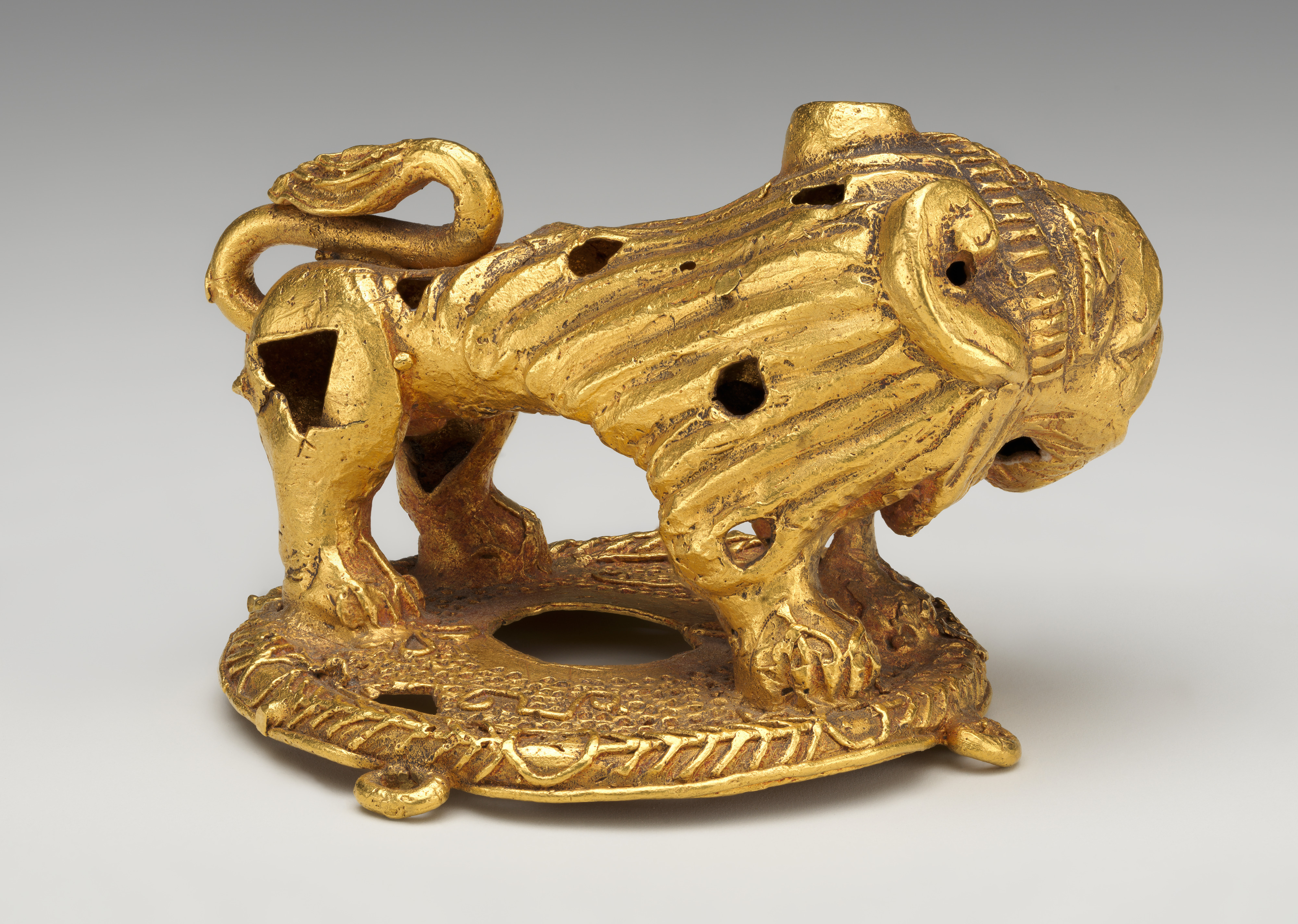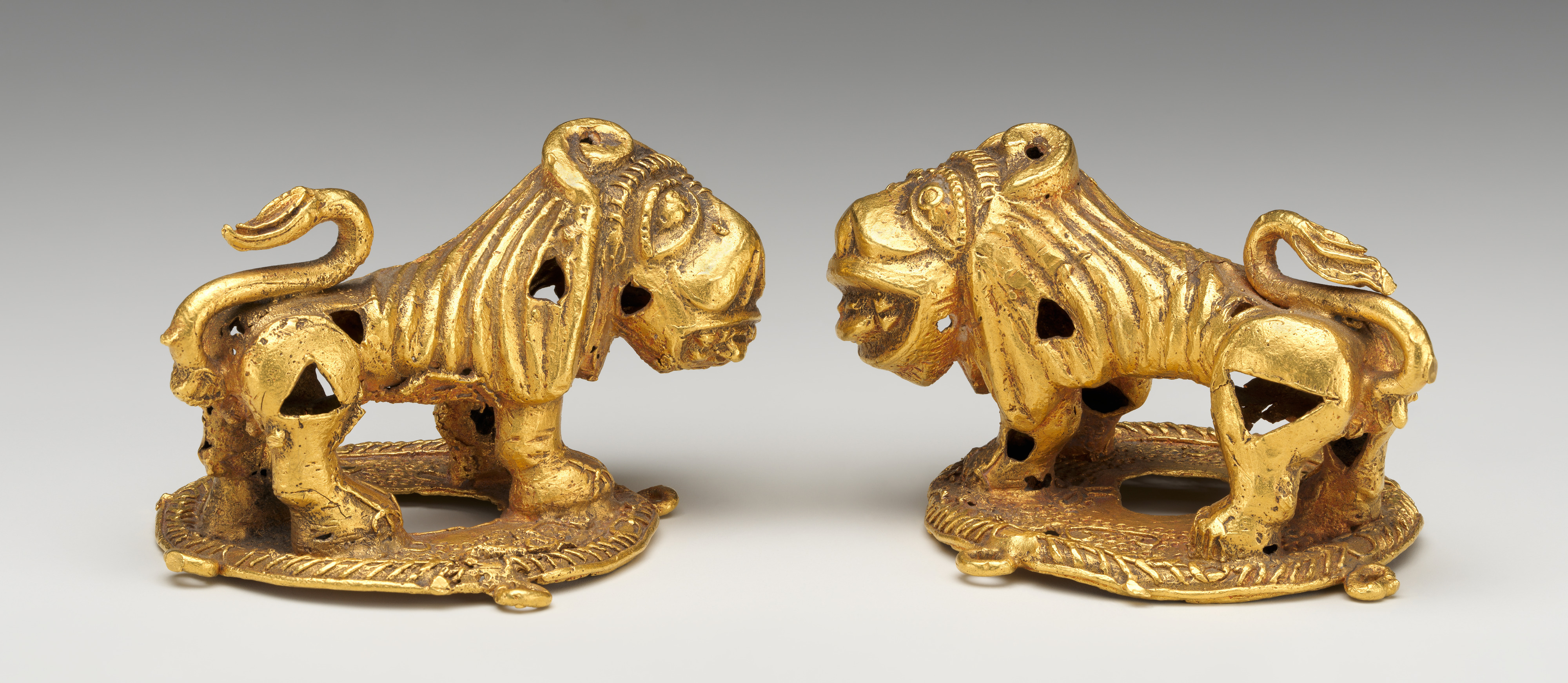Lion Ornament
Not on view
One of a pair (along with 1979.296.227), this commanding gold ornament of a lion was a symbol of Akan royal power. The animal’s head is oversized in comparison to the rest of its body, and turns to the side to regard the viewer. Filled by large circular pupils, the oval-shaped eyes tilt downwards on the diagonal. The mouth opens in a wide half circle to reveal the tongue poking through the pointed incisor teeth. The stout torso tapers from the head to the hips, where it joins well-muscled back legs supported by large paws. The s-shaped tail curves back on itself to rest on the lower back; the hairs of its tufted end are indicated with soft vertical depressions. The ornament is hollow, and contains several triangular cutouts on the flanks, torso, and legs; these allowed the ornament to be both lightweight, and for the artist to conserve the precious medium of yellow gold. The lion stands on a ring-shaped base edged with a flattened rope border: this textured detail, as well as the twisting outlines around the eyes and along the hairline may have been created using a filigree or gold-beading technique. A series of four evenly spaced small rings are attached horizontally along the perimeter of the base. This ornament was likely made using the lost wax casting method, in which a model is created in wax, surrounded with a clay investiture that is then baked (allowing the wax to melt out), and then filled with molten metal. As each casting made using this process is unique, there are subtle differences in the bodies, facial features, and openwork areas on each golden animal. These differences are particularly evident in the muzzle: in one example, the tongue is wide and fleshy, and the flattened cheeks curve upwards to form a triangular snub nose with pointy nostrils; in the second example, the tongue is as a narrow rectangular projection, while the rounded triangular nose is framed by the padded lower cheeks. Additionally, one lion faces to the right, while the other faces to the left, suggesting that they were meant to flank another object.
The leadership of the Asante Empire, with its multiple states and elaborate hierarchy, were patrons of a complex of regalia, symbols, and proverbs that reflected upon the royal status, grandeur, and personal qualities of the sovereign. Historically, only royals and members of their entourage could possess precious metals like locally mined gold (sika) and imported silver. Akan gold production likely began in the second half of the fifteenth century, yielding approximately fourteen million ounces of metal by 1900. Gold circulated in powdered form (sika futuro) as the currency of the Asante Empire and many of its neighbors until 1901; when not accumulated as a form of personal wealth, gold dust was melted down and cast into fashionable ornaments. Regalia—including woven textiles and elaborate gold ornaments—have been omnipresent aspects of Akan courtly life since at least the fifteenth century. Members of the royal goldsmiths' guild exclusively produced gold ornaments, including staffs and rings. According to oral tradition, these highly skilled artists claimed ancestry from Fusu Kwabi, who supposedly descended from heaven in the 1400s to teach men how to work gold. Gold was not only a means of wealth and a way of displaying status, but also a spiritual substance. The shining metal was believed to be the earthly embodiment of the sun, and thus the force of life itself (kra).
Among the most potent royal symbols was the leopard, a creature endemic to the forested Akan region. The leopard dominated both Akan visual and oral arts related to royals until the late nineteenth century, when it was replaced by the lion. While the Akan had been exposed to images of lions in European heraldry and other media since the late fifteenth century, images of lions did not become part of the visual vocabulary of Akan royal regalia until the 1820s. The frequent use of the lion as a logo for foreign trading companies provided Akan artists with various models, and after 1902, when the area now known as Ghana became a British colony, the lion on British heraldry and goods became ubiquitous. Art historian Doran Ross has linked the particular pose of this ornament to a heraldic lion known as the "statant guardant:" the former part of the phrase refers to the four paws placed on the ground, while the latter part refers to the turned head. It was at this point that the lion supplanted the leopard as the preferred feline symbol of the Akan ruler, a dominant spot that it retains to this day. Like its spotted counterpart, the lion in Akan art represented the positive qualities of a chief, including strength, courage, and wisdom. Tooth-baring lions such as this example have been associated with a proverb that implores one to listen to chiefly warnings: "If the lion has no intention to attack, it will not show its teeth." (Ross 1981, 166)
It has been suggested that this golden lion and its counterpart (1979.296.227) may have adorned a pair of royal sandals, a sword-bearer’s hat, or served as finials for a prestige chair. The series of loops at the base could have been used to fasten it to any of the aforementioned objects. A similar object with a lion motif and flat base with loops, identified as a sword ornament, in the collection of the treasury of the Nsutahene in Nsuta, Ghana, indicates yet another possible use. (Ross 1981, fig. 2). Lions in the "statant guardant" pose adorn two other royal Akan objects in the Met’s collection: a pair of leather sandals (1999.47.104a, b), and a stool (1976.315). Once a symbol of European colonial authority in the colony of the Gold Coast (present-day Ghana), the heraldic lion has been transformed into the emblem par excellence of the Akan ruler. It also figures prominently in Ghana’s current national coat of arms, designed by Ghanaian artist Amon Kotei in 1957.
Kristen Windmuller-Luna, 2016
Sylvan C. Coleman and Pam Coleman Memorial Fund Fellow in the Department of the Arts of Africa, Oceania, and the Americas
Published references
Ross, Doran H. "The Heraldic Lion in Akan Art: A Study of Motif Assimilation in Southern Ghana." Metropolitan Museum Journal 16 (1981): 165-80.
Further reading
Cole, Herbert M., and Doran H. Ross. The Arts of Ghana. Los Angeles: Museum of Cultural History, 1977.
Garrard, Timothy F. "The Akan of Ghana." In African Gold: Jewellry and Ornaments from Ghana, Cote D'Ivoire, Mali and Senegal in the Collection of the Gold of Africa, Barbier-Mueller Museum in Cape Town. New York/Munich: Prestel, 2011.
Ross, Doran H., Georg Eisner, and Leslie Jones. Royal Arts of the Akan: West African Gold in Museum Liaunig. Neuhaus/Suha: HL Museumverwaltung, 2009.
Wilks, Ivor. Forests of Gold: Essays on the Akan and the Kingdom of Asante. Athens: Ohio University Press, 1993.
Due to rights restrictions, this image cannot be enlarged, viewed at full screen, or downloaded.
This artwork is meant to be viewed from right to left. Scroll left to view more.





